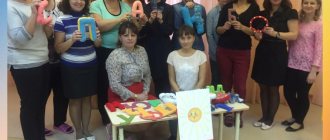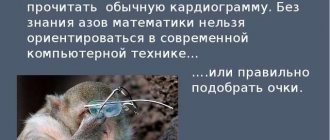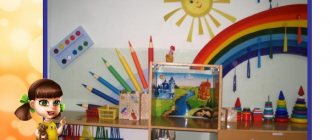Speech therapist in kindergarten
The work of a speech therapist in a kindergarten has the main goals of early and timely identification of children with speech defects and providing them with appropriate speech therapy assistance. This goal is achieved by solving certain problems.
The speech therapy group is a specialized unit in a preschool institution designed to educate children with speech disorders. Selection criteria, pros and cons for the child. Among the many preschool institutions, speech therapy kindergartens have their own characteristics. You can also find separate speech therapy groups in combined kindergartens.
The section of the site for speech therapists in kindergartens for different groups contains many interesting publications for speech therapists on teaching children on various topics:
- Summary of the project dedicated to Victory Day, preparatory (speech therapy) group for school
- An open lesson with elements of fairy tale therapy for children of the senior speech therapy group “The Tale about the House in which Nobody Wanted to Live”
- Lesson on valeology in kindergarten on the topic “How we breathe”
- Work program of a speech therapist at a kindergarten speech center
- Summary of speech therapy classes in kindergarten
- Summary of frontal speech therapy classes in kindergarten
- Experimental study on the elimination of speech disorders in preschool children with general speech underdevelopment
- Work program of the preparatory speech therapy group of the kindergarten
- Speech therapist consultation
- Summary of the final comprehensive lesson “Luntik and his friends” in the senior group for children with ODD
- ECD with children of the preparatory group 6-7 years old with speech impairments on the topic “Visiting indoor plants”
- Summary of a subgroup lesson in kindergarten on correcting sound pronunciation in older children “Automation of the sound of L. Visiting Smeshariki”
- Summary of a speech therapy lesson in kindergarten “The Sun Visiting the Children”
- Summary of a speech therapy lesson in 1st grade on the development of lexical and grammatical means of language on the topic “Winter's Tale”
- Individual work with children to consolidate EMF in a preparatory speech therapy group
- Physical education lessons in kindergarten in verses based on logorhythmics
A speech therapist in kindergarten is a specialist who helps to formulate speech correctly and diagnoses the state of speech function. To determine defects, he conducts the necessary tests - this process is called a speech therapy examination. They can be carried out in the office of a speech therapist-teacher, kindergarten, or at home. Sometimes a small patient with severe deviations is sent to special kindergartens that correct speech.
A speech therapist in kindergarten should monitor children and identify their speech defects. It is quite easy for a speech therapist in a preschool institution to do this. Every kindergarten should have a speech therapist. Firstly, he conducts separate classes with children who have been diagnosed with speech pathology (general speech underdevelopment, dyslalia, dysarthria), and the plans for the work of this specialist should include group developmental lessons.
Speech development of children 2-3 years old
Experts consider the age from two to three years to be critical in terms of speech development and recommend making the first visit to a speech therapist to answer the question “is everything okay with speech?”
Sound pronunciation. In the speech of a child of the third year of life, the sounds [s'], [l'], [y'], as well as [g], [x], [k], [m], [p], [b] should appear. , [n], [v], [f], [d], [t] (and their soft pairs), all vowels. However, the pronunciation of many sounds is still far from perfect, which at this age stage is characteristic of children's speech, since the mobility of the muscles of the tongue and lips is not yet sufficiently developed. The child replaces many difficult sounds with easier ones to pronounce. Thus, the baby often replaces hissing sounds ([sh], [zh], [ch'], [sch'] with soft whistling sounds: “syapka” (hat), “zyuk” (beetle), “tsyaynik” (teapot), "senok" (puppy). Sometimes, instead of the sound [ch'], a child can pronounce [t']: “tyasy” (clock). Some children at this age replace hissing sounds with hard whistling sounds: “sapka” instead of hat; hard whistling - soft whistling: “syanki” (sledge), “zyayka” (bunny). The consonants [р], [р'], [л] are absent or replaced by the sounds [л'], [й]: “yba” (fish), “giya” (weight), “yaboko” (apple), “dvel” (door), “golubi” (pigeons), “may” (chalk).
Lexicon. The child’s passive and active vocabulary quickly expands: by the age of 2 it reaches approximately 300 words, and by the age of 3 – up to 1000 words. In addition to nouns and verbs, the child increasingly uses adjectives, adverbs, prepositions, and pronouns. In the third year of life, the baby listens with pleasure and perceives simple fairy tales and stories, and easily carries out simple verbal instructions.
Phrasal speech . Experts are unanimous that by the age of 2, the baby should already have formed phrasal speech. Even if the phrases are not always clear yet and consist of two words, often babbling. For example: MOTHER, PI (mom, I’m thirsty). DE UYAT (let's go for a walk). The main thing is that a phrase (sentence) appeared. But the sentences of three-year-old children become complex, with conjunctions “because”, “or”, “so that”. And, although in their speech there is still a lot of incorrect use of endings (“Look how many balls!”), suffixes (“I have a doll”), agreements (“This is my doll!”), stresses (“The spoon is on the table” ), gradually they become less and less, they become random and disappear at approximately 5-6 years.
Speech development of children 3-4 years old
The fourth year is the age of “why”. Children constantly ask adults questions that cannot be ignored. We must patiently and clearly answer all the “why?”, “why?”, “how?” During this period, the child’s greatest sensitivity to language is revealed.
Sound pronunciation. A child of the fourth year of life correctly pronounces the whistling sounds [s], [z] and [ts]. At this age, he still cannot always correctly pronounce the hissing sounds [w], [zh], [ch'], [sh'] and often replaces them with whistling sounds [s], [z], [ts]: “kasa” ( porridge), “nozyk” (knife), “klyuts” (key). The baby can replace sonorant [r], [r'], [l] with the sound [l'], less often [th]: “lyabota” (work), “leka” (river), “lyampa” (lamp), “kayandas” "(pencil), "get tired" (tired).
The syllabic structure of the word. In some words, the child omits or rearranges not only sounds, but also entire syllables, for example, he can pronounce the word car as “amabil”, store as “gamazin”, suitcase as “bagman”, temperature as “tematura”, etc. But this applies to words with a complex syllabic structure, to long and new words.
Lexicon. By age four, a child's active vocabulary nearly doubles to approximately 2,000 words. In his speech, in addition to nouns and verbs, pronouns (my, yours, ours), adverbs (cold, tasty), and numerals (one, two) appear more and more often. If previously the child used only qualitative adjectives (soft, warm), now he also uses possessive ones (uncle's hat, cat's tail).
The grammatical structure of speech is still being formed, so incorrect use of endings, suffixes, prefixes, and word agreements in a sentence is acceptable (“Buy a blue ball!”, “This little dog was sitting under the chair,” “I’m drawing”). Arbitrary use of stress is also a variant of the norm: “cold water”, “my hand hurts”.
Phrasal speech. The construction of phrases also becomes more complicated. If earlier the baby, asking for an apple, said: “Give me an apple,” now he can pronounce this phrase like this: “Give me a big (small or red) apple,” that is, indicate the size or color of the object. However, a child cannot always coherently and clearly tell what he saw on the street or retell a fairy tale.
Speech development of children 4-5 years old
In the fifth year of life, the child’s speech becomes more varied, more correct, and richer.
Sound pronunciation. Children of this age master a clear and pure pronunciation of hissing sounds [w], [zh], [h'], [sh'], many begin to correctly pronounce the sounds [r], [r'], [l], but not always yet know how to use them in all words. So, for example, a child will correctly pronounce the sound [r] in the word barn and at the same time the same sound in the word roof can be pronounced as [l]: klysha. Normally, five-year-old children should learn to clearly pronounce all the sounds in words and sentences.
Intonation, pitch, strength of voice. Children catch various intonation means of expressiveness in the speech of adults and imitate them when retelling a fairy tale. They can arbitrarily change the pitch and strength of their voice, taking into account the content of the story. At this age they can already speak in a whisper.
Formation of sound analysis skills. A new development in the fifth year of life is the ability to recognize the sound in a word, as well as the selection of words with a given sound, that is, the simplest forms of sound analysis develop.
Lexicon. An increase in the active vocabulary (by the age of five it reaches 3000 words) allows the child to more accurately express his thoughts and communicate freely with both adults and children. If a five-year-old child does not know what to call this or that object, then, trying to find the appropriate word, he creates his own words. K.I. Chukovsky in his book “From Two to Five” gives the following examples of children’s word creation: ogonyata (small fire), angry (wrinkles), shoe. Children show great interest in the sound design of words, begin to select consonant pairs of words, and compose short poems. During this period, children's speech hearing improves. They get the opportunity to distinguish words that differ in one phoneme (stick - beam, bear - mouse).
The grammatical structure of speech is still being formed, so incorrect use of endings, suffixes, prefixes, and word agreements in a sentence is acceptable (“Buy a blue ball!”, “I’m drawing”). Arbitrary use of stress is also a variant of the norm: “cold water”, “my hand hurts”.
Coherent speech. Children begin to master monologue speech. A child of middle preschool age should be able to coherently talk about events from his own life, describe animals or toys that replace them, talk about the event depicted in a picture or a series of pictures. He is able to retell a familiar text. A child of the fifth year of life constructs his answers from 2-3 or more phrases, and increasingly his speech includes complex and complex sentences.
Speech development of children 5-6 years old
The development of the speech of an older preschooler, the ability to coherently, consistently, logically express one’s thoughts, and the development of phonemic hearing are the most important points in preparing children for school.
Sound pronunciation. By the age of five, the formation of correct sound pronunciation ends. Normally, all children should learn to clearly pronounce all sounds in words and sentences. This does not always happen. Some children have various deficiencies in sound pronunciation, associated either with disturbances in the structure and mobility of the articulatory apparatus, or with underdevelopment of phonemic hearing. Attention parents! Urgently contact speech therapists so that they can establish the cause of incorrect sound pronunciation and draw up a program for correcting the disturbed sounds.
Intonation, pitch, strength of voice. Most children can voluntarily change the strength and pitch of their voice depending on the purpose of the statement (question, exclamation). By the age of five, you need to normalize your speech rate. Both a rapid rate of speech, which leads to unclear, sloppy pronunciation with blurred articulation, and a slow rate, which creates difficulties in communication, are undesirable.
Formation of sound analysis skills . With appropriate training, the child masters not only determining the position of a sound in a word (beginning, middle, end of a word), but also establishes the exact place of a sound in a word, naming the sounds in the order in which they appear in the word. This is a necessary prerequisite for learning to read and write.
Lexicon . After five years, vocabulary grows rapidly. If in previous years it was possible to roughly count how many words are in active use, now it is more difficult to do this. Involuntary memory, the basis for vocabulary acquisition, reaches its peak at this age. Words are remembered as if by themselves, without volitional effort. A word heard once easily enters the active dictionary.
The grammatical structure of speech . Children learn not only typical forms of inflection and word formation, but also exceptions to the rules, morphemes also fall into place, and cases of word creation become fewer and fewer. Nevertheless, errors may remain in the use of forms with alternating sounds (want - want), in the use of plural forms of nouns in the nominative and genitive cases (tree - tree, pencils - no pencils), and so on.
Coherent speech. The child has sufficiently developed active speech, uses detailed phrases during communication, answers questions accurately and clearly, and is able to talk about the events he witnessed.
Speech development of children 6-7 years old
At this age, the preschool period of child development ends, the main result of which is readiness for systematic learning.
Sound pronunciation . By the age of six, children’s sound pronunciation has completely normalized, and work is underway to improve diction, that is, the ability to correctly use sounds in the flow of speech.
Phonemic hearing. Six-year-old children clearly distinguish by ear all the sounds of their native language, including those that are similar in their acoustic characteristics: dull and voiced, hard and soft. The inability to distinguish pairs of sounds based on deafness and voicedness most often indicates a deficiency in physical hearing. According to the outstanding Russian teacher K.D. Ushinsky, “a good, clear pronunciation of a word such that each of the sounds that make up the word is heard, and a sensitive ear in distinguishing these sounds - these are the main foundations of spelling.”
Formation of sound analysis skills . The ability to recognize sounds in a stream of speech, isolate them from a word, and establish the sequence of sounds in a particular word is developing. It should be noted that without the participation of adults, these very necessary skills may not be formed at all.
Lexicon . The vocabulary of preschool children of six or seven years of age is quite large and can no longer be accurately counted, especially since there is a large gap in quantitative terms among children with different speech development: there are children with a rich vocabulary, very knowledgeable in various fields of knowledge, and children whose vocabulary very poor and limited to everyday topics.
Grammatical structure . Preschoolers have already mastered practical grammar; errors may remain in the use of forms that are exceptions: some verbal forms of conjugations (to go - go); indeclinable nouns (in palta) and other speech errors that are characteristic not only of preschoolers, but are also found in the speech of adults, since they are forms that are objectively difficult to master.
Connected speech . Answers questions in detailed phrases, uses complex and complex sentences. He can independently compose a story based on a picture, retell a familiar fairy tale or story, share his impressions of a cartoon or book he watched. A child can fantasize and compose fairy tales.





